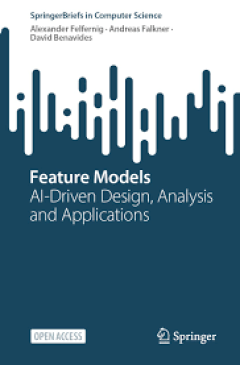Filter by

Biodiversity and Health in the Face of Climate Change
This open access book identifies and discusses biodiversity’s contribution to physical, mental and spiritual health and wellbeing. Furthermore, the book identifies the implications of this relationship for nature conservation, public health, landscape architecture and urban planning – and considers the opportunities of nature-based solutions for climate change adaptation. This transdiscipli…
- Edition
- 1
- ISBN/ISSN
- 978-3-030-02318-8
- Collation
- XXVI, 481 halaman
- Series Title
- -
- Call Number
- 570 BIO

Semantic Systems. In the Era of Knowledge Graphs; 16th International Conferen…
Buku akses terbuka ini merupakan hasil prosiding yang telah melalui proses sejawat dari Konferensi Internasional ke-16 tentang Sistem Semantik, SEMANTiCS 2020, yang diadakan di Amsterdam, Belanda, pada bulan September 2020. Konferensi ini diadakan secara virtual karena pandemi COVID-19.
- Edition
- -
- ISBN/ISSN
- 978-3-030-59833-4
- Collation
- 1 online resource (XIII, 127 Pages)
- Series Title
- -
- Call Number
- 006.3 BLO s

Advances in Intelligent Data Analysis XVIII; 18th International Symposium on …
Buku akses terbuka ini merupakan hasil dari Konferensi Internasional ke-18 tentang Analisis Data Cerdas, IDA 2020, yang diadakan di Konstanz, Jerman, pada bulan April 2020. 45 makalah lengkap yang disajikan dalam volume ini ditinjau dan dipilih dengan saksama dari 114 kiriman. Memajukan Analisis Data Cerdas memerlukan ide-ide baru yang berpotensi mengubah permainan. Misi IDA adalah untuk mempro…
- Edition
- -
- ISBN/ISSN
- 978-3-030-44584-3
- Collation
- 1 online resource (XIV, 588 Pages)
- Series Title
- -
- Call Number
- 006.3 BER a c.1

Feature Models : AI-Driven Design, Analysis and Applications
This open access book provides a basic introduction to feature modelling and analysis as well as to the integration of AI methods with feature modelling. It is intended as an introduction for researchers and practitioners who are new to the field and will also serve as a state-of-the-art reference to this audience. While focusing on the AI perspective, the book covers the topics of feature mode…
- Edition
- -
- ISBN/ISSN
- 978-3-031-61874-1
- Collation
- X, 122
- Series Title
- SpringerBriefs in Computer Science (BRIEFSCOMPUTER)
- Call Number
- 001 FEL f

Theoretical and Experimental Studies on Steady-State Microbunching
This open access book is devoted to the theoretical and experimental studies of a novel accelerator light source mechanism called steady-state microbunching (SSMB) which promises high-power, high-repetition rate, narrow-band coherent radiation in an electron storage ring. The contribution of this dissertation consists of three parts: first, answers the question of how to realize SSMB from a bea…
- Edition
- -
- ISBN/ISSN
- 978-981-99-5800-9
- Collation
- XII, 160
- Series Title
- Springer Theses (Springer Theses)
- Call Number
- 530 DEN t

Particle Accelerator Physics
This book by Helmut Wiedemann is a well-established, classic text, providing an in-depth and comprehensive introduction to the field of high-energy particle acceleration and beam dynamics. The present 4th edition has been significantly revised, updated and expanded. The newly conceived Part I is an elementary introduction to the subject matter for undergraduate students. Part II gathers the …
- Edition
- -
- ISBN/ISSN
- 978-3-319-18317-6
- Collation
- XXIX, 1021
- Series Title
- Graduate Texts in Physics (GTP)
- Call Number
- 530 WIE p

Bruno Touschek 100 Years
This open access book celebrates the contribution of Bruno Touschek to theoretical physics and particle colliders in Europe. It contains direct testimonials from his former students, collaborators, and eminent scientists, among them, two Nobel Prize winners in Physics, Giorgio Parisi and Carlo Rubbia. It reviews the main developments in theoretical and accelerator physics in the second half of …
- Edition
- 1
- ISBN/ISSN
- 978-3-031-23042-4
- Collation
- X, 307
- Series Title
- -
- Call Number
- -

Artificial Intelligence and Cognitive Science : 30th Irish Conference, AICS 2…
This open access book constitutes selected papers presented during the 30th Irish Conference on Artificial Intelligence and Cognitive Science, held in Munster, Ireland, in December 2022. The 41 presented papers were thoroughly reviewed and selected from the 102 submissions. They are organized in topical sections on machine learning, deep learning and applications; responsible and trustwo…
- Edition
- -
- ISBN/ISSN
- 978-3-031-26438-2
- Collation
- XIV, 540
- Series Title
- Communications in Computer and Information Science (CCIS, volume 1662)
- Call Number
- 001 ART

The Politics of Diversity in Music Education
This open access book examines the political structures and processes that frame and produce understandings of diversity in and through music education. Recent surges in nationalist, fundamentalist, protectionist and separatist tendencies highlight the imperative for music education to extend beyond nominal policy agendas or wholly celebratory diversity discourses. Bringing together high-level …
- Edition
- 1
- ISBN/ISSN
- 9783030656171
- Collation
- X, 214
- Series Title
- -
- Call Number
- -
Visions for Intercultural Music Teacher Education
This open access book highlights the importance of visions of alternative futures in music teacher education in a time of increasing societal complexity due to increased diversity. There are policies at every level to counter prejudice, increase opportunities, reduce inequalities, stimulate change in educational systems, and prevent and counter polarization. Foregrounding the intimate connectio…
- Edition
- 1
- ISBN/ISSN
- 9783030210298
- Collation
- X, 219
- Series Title
- -
- Call Number
- -
 Computer Science, Information & General Works
Computer Science, Information & General Works  Philosophy & Psychology
Philosophy & Psychology  Religion
Religion  Social Sciences
Social Sciences  Language
Language  Pure Science
Pure Science  Applied Sciences
Applied Sciences  Art & Recreation
Art & Recreation  Literature
Literature  History & Geography
History & Geography